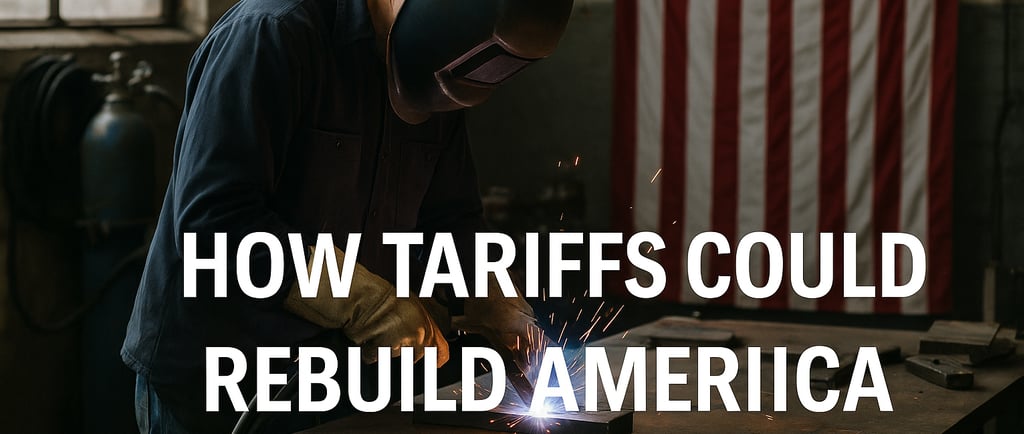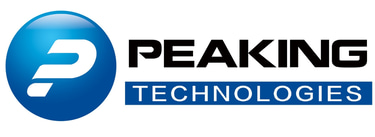💡 The Bright Side of Tariffs: How Trade Changes Could Inspire a Smarter, Stronger America
If you've read the headlines lately, you might be feeling uneasy. With steep tariffs on imported electronics and everyday items, it seems like everything is getting more expensive. But behind the sticker shock, something else is happening—something potentially transformative.
4/19/20253 min read


If you've read the headlines lately, you might be feeling uneasy. With steep tariffs on imported electronics and everyday items, it seems like everything is getting more expensive. But behind the sticker shock, something else is happening—something potentially transformative.
🏭 Reviving American Manufacturing and Jobs
America lost nearly 5 million manufacturing jobs from 2000 to 2010. With tariffs now making imported goods less competitive, domestic production has a chance to rise again. Tariffs of up to 145% on Chinese goods are pushing companies to consider reshoring operations or diversifying supply chains to friendlier nations like Mexico or Vietnam.
This shift isn’t just good for the economy—it’s good for small towns, skilled workers, and even high school grads who want career paths outside tech or academia.
🔄 Embracing Quality Over Quantity
The cheap $30 toaster may soon be a thing of the past. With increased import costs, consumers will likely gravitate toward durable, higher-quality goods. That’s a cultural win. We’ve been stuck in a cycle of buy-break-dispose—tariffs could be the unexpected catalyst that helps us break free.
Similar to France’s “repairability score” on consumer electronics, rising U.S. prices could push brands and buyers to favor repairable, long-lasting designs.
♻️ The Rise of Refurbished and Circular Markets
In 2023, refurbished smartphone shipments rose 9.5%, reaching over 282 million units. Platforms like Back Market, Gazelle, and even Amazon Renewed are capitalizing on this shift. Higher new product prices will make secondhand gadgets even more attractive—and more socially acceptable.
The refurbished revolution isn't just economical. It's environmentally sound and opens doors for new local businesses—from repair shops to resale specialists.
🚀 Innovation Through Necessity
Trade pressure breeds innovation. Modular phones like the Fairphone, once a niche idea, now represent a vision for a repairable, sustainable tech future. Expect similar creativity from startups—especially as barriers to entry drop when imports lose their pricing edge.
Companies forced to cut costs and rethink materials might surprise us with breakthroughs in product design, recyclability, and sourcing.
📈 Yes, Prices May Rise. But Mindsets Will Too.
While the price hike on toasters, strollers, and small appliances is real, it doesn't have to be unbearable. If consumers shift from impulsive spending to intentional buying, the inflationary impact becomes more of a growing pain than a permanent burden.
Buy less, buy better, fix more. That’s the mindset of the new American shopper.
🤝 Supply Chain Realignment Takes Time
China’s dominance in electronics manufacturing wasn't built in a day. Replacing it with a diversified network across countries like India, Mexico, and even domestic suppliers will take years. But the end result? A more resilient supply chain, less prone to geopolitical shocks.
This diversification may eventually lead to better quality control, stronger labor standards, and faster product innovation.
👨👩👧 Everyday Impacts, Community Benefits
Here’s how this could show up in your life:
Your next blender might be made in Ohio, not overseas.
Your teenager might start a side hustle fixing broken phones.
You might buy a refurbished iPad—and feel proud of the choice.
Your neighbor might get hired at a small electronics plant that just opened down the road.
This isn’t just about trade. It’s about how we live, buy, and build.
🌱 Final Thoughts: Tariffs as a Catalyst for Change
Tariffs are blunt tools—but they spark necessary conversations. They challenge old habits and force businesses to innovate. They encourage consumers to be thoughtful and sustainable. And they may just help America rediscover its industrial roots.
Yes, your next gadget might cost a little more. But it might last longer. It might be fixable. It might even be made down the street.
And maybe that’s not such a bad deal after all.
📚 Sources
Vox: Why Tariffs Will Make Electronics More Expensive (2025)
Counterpoint Research – Refurbished Smartphone Market 2023
